
William the Lion, sometimes styled William I and also known by the nickname Garbh, 'the Rough', reigned as King of Alba from 1165 to 1214. His almost 49-year-long reign was the longest for a Scottish monarch before the Union of the Crowns in 1603.
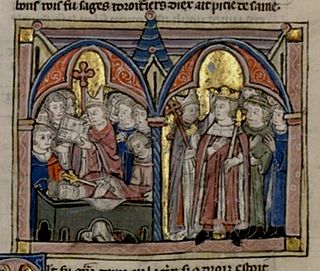
Year 1174 (MCLXXIV) was a common year starting on Tuesday of the Julian calendar, the 1174th year of the Common Era (CE) and Anno Domini (AD) designations, the 174th year of the 2nd millennium, the 74th year of the 12th century, and the 5th year of the 1170s decade.

The Wars of Scottish Independence were a series of military campaigns fought between the Kingdom of Scotland and the Kingdom of England in the late 13th and 14th centuries.

Northumberland is a ceremonial county in North East England, bordering Scotland. It is bordered by the Scottish Borders to the north, the North Sea to the east, Tyne and Wear and County Durham to the south, and Cumbria to the west. The town of Blyth is the largest settlement. Northumberland is the northernmost county in England.

Berwick-upon-Tweed, sometimes known as Berwick-on-Tweed or simply Berwick, is a town and civil parish in Northumberland, England, 2.5 mi (4 km) south of the Anglo-Scottish border, and the northernmost town in England. The 2011 United Kingdom census recorded Berwick's population as 12,043.
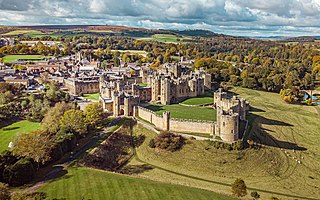
Alnwick is a market town in Northumberland, England, of which it is the traditional county town. The population at the 2011 Census was 8,116.
Ranulf de Glanvill was Chief Justiciar of England during the reign of King Henry II (1154–89) and was the probable author of Tractatus de legibus et consuetudinibus regni Anglie, the earliest treatise on the laws of England.
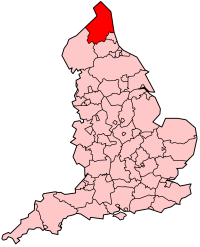
Northumberland, England's northernmost county, is a land where Roman occupiers once guarded a walled frontier, Anglian invaders fought with Celtic natives, and Norman lords built castles to suppress rebellion and defend a contested border with Scotland. The present-day county is a vestige of an independent kingdom that once stretched from Edinburgh to the Humber, hence its name, meaning literally 'north of the Humber'. Reflecting its tumultuous past, Northumberland has more castles than any other county in England, and the greatest number of recognised battle sites. Once an economically important region that supplied much of the coal that powered the industrial revolution, Northumberland is now a primarily rural county with a small and gradually shrinking population.
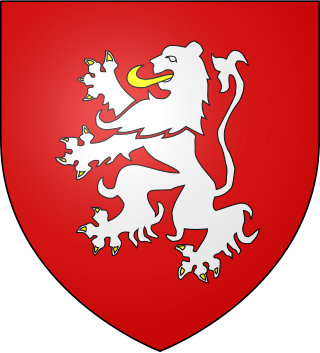
Ranulf II, 4th Earl of Chester (1099–1153), was an Anglo-Norman baron who inherited the honour of the palatine county of Chester upon the death of his father Ranulf Meschin, 3rd Earl of Chester. He was descended from the Counts of Bessin in Normandy.
This timeline summarises significant events in the history of Northumbria and Northumberland.
Sir Archibald Douglas was a Scottish nobleman, Guardian of Scotland, and military leader. He is sometimes given the epithet "Tyneman", but this may be a reference to his great-nephew Archibald Douglas, 4th Earl of Douglas. He fought and died at the Battle of Halidon Hill.
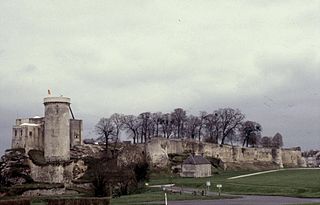
The Treaty of Falaise was a forced written agreement made in December 1174 between the captive William I, King of Scots, and Henry II, King of England.
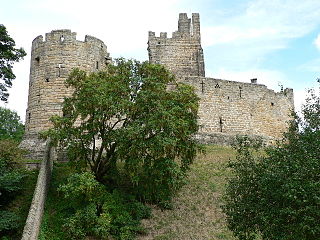
Prudhoe Castle is a ruined medieval English castle situated on the south bank of the River Tyne at Prudhoe, Northumberland, England. It is a Scheduled Ancient Monument and a Grade I listed building.
The Battle of Alnwick is one of two battles fought near the town of Alnwick in Northumberland, England. In the battle, which occurred on 13 November 1093, Malcolm III of Scotland, later known as Malcolm Canmore, was killed together with his son Edward by an army of English knights led by Robert de Mowbray.
Events from the 1170s in England.
In July 1482 an English army invaded Scotland during the Anglo-Scottish Wars. The town of Berwick-upon-Tweed and its castle were captured and the English army briefly occupied Edinburgh. These events followed the signing of the Treaty of Fotheringhay, 11 June 1482, in which Alexander Stewart, Duke of Albany, the brother of James III of Scotland declared himself King of Scotland and swore loyalty to Edward IV of England. The follow-up invasion of Scotland under the command of Edward's brother, Richard, Duke of Gloucester failed to install Albany on the throne, but Berwick has remained English ever since the castle surrendered on 24 August. The English army left Edinburgh with a promise for the repayment of the dowry paid for the marriage of Princess Cecily of England to the Scottish Prince.
Humphrey III de Bohun of Trowbridge Castle in Wiltshire and of Caldicot Castle in south-east Wales, 5th feudal baron of Trowbridge, was an Anglo-Norman nobleman and general who served King Henry II as Lord High Constable of England.
The Treaty of Abernethy was signed at the Scottish village of Abernethy in 1072 by King Malcolm III of Scotland and by William of Normandy.
Burnt Candlemas was a failed invasion of Scotland in early 1356 by an English army commanded by King Edward III, and was the last campaign of the Second War of Scottish Independence. Tensions on the Anglo-Scottish border led to a military build-up by both sides in 1355. In September a nine-month truce was agreed, and most of the English forces left for northern France to take part in a campaign of the concurrent Hundred Years' War. A few days after agreeing the truce, the Scots, encouraged and subsidised by the French, broke it, invading and devastating Northumberland. In late December the Scots escaladed and captured the important English-held border town of Berwick-on-Tweed and laid siege to its castle. The English army redeployed from France to Newcastle in northern England.
The sieges of Berwick were the Scottish capture of the town of Berwick-upon-Tweed on 6 November 1355 and their subsequent unsuccessful siege of Berwick Castle, and the English siege and recapture of the town in January 1356. In 1355 the Second War of Scottish Independence had been underway for over 22 years. After a period of quiescence the Scots, encouraged by the French who were fighting the English in the Hundred Years' War, assembled an army on the border. In September a truce was agreed and much of the English army left the border area to join King Edward III's campaign in France.









